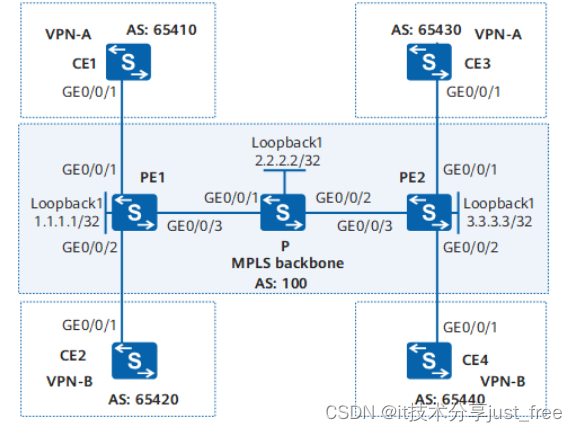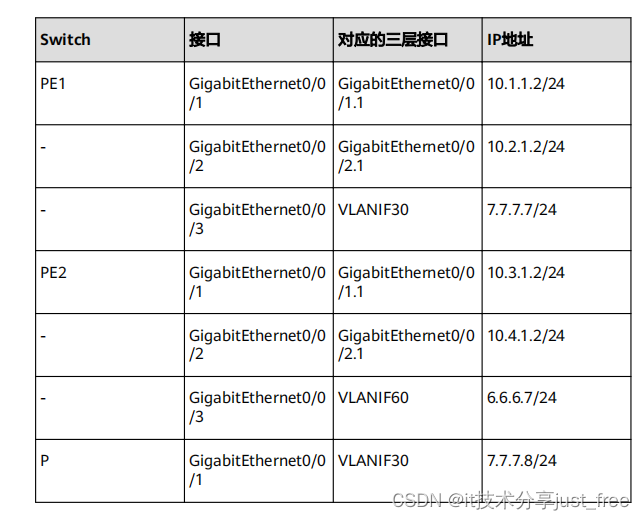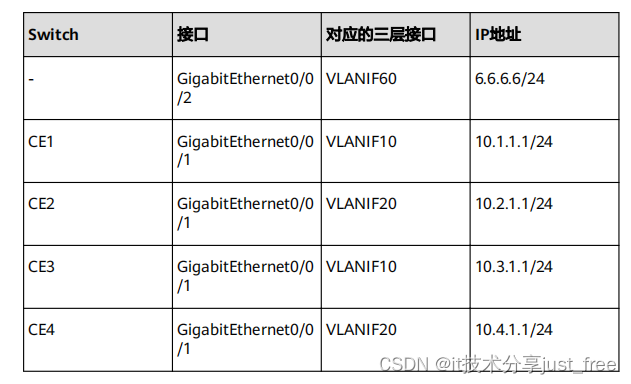组网需求
如 图 7-13 , CE1 、 CE3 属于 VPN-A , CE2 、 CE4 属于 VPN-B ; VPN-A 使用的 VPN-target
属性为 111:1 , VPN-B 使用的 VPN-target 属性为 222:2 。不同 VPN 用户之间不能互相访
问。
图 7-13 配置 Dot1q 终结子接口接入 L3VPN 组网图



配置思路
采用如下的思路配置 Dot1q 子接口接入 L3VPN :
- 骨干网中,与 CE 相连的 PE 上需配置 VPN 实例,并把与 CE 相连的接口和相应的 VPN
实例绑定;绑定之后配置与 CE 相连的接口的 IP 地址。
- PE 与 PE 之间配置 OSPF 实现 PE 之间的互通。
- 配置 MPLS 基本能力和 MPLS LDP ,建立 MPLS LSP 。
- 配置 MP-IBGP 交换 VPN 路由信息。
- CE 与 PE 之间配置 EBGP 交换 VPN 路由信息。
- 在 PE 连接 CE 的接口上配置 Dot1q 子接口接入 L3VPN 。
说明
VCMP 的角色是 Client 时,不能配置 VLAN 终结子接口。
操作步骤
步骤 1 在 MPLS 骨干网上配置 IGP 协议,实现骨干网 PE 和 P 的互通
配置 PE1 。
<HUAWEI> system-view
HUAWEI\] **sysname PE1**
\[PE1\] **router id 1.1.1.1**
\[PE1\] **interface loopback 1**
\[PE1-LoopBack1\] **ip address 1.1.1.1 32**
\[PE1-LoopBack1\] **quit**
\[PE1\] **vlan batch 30**
\[PE1\] **interface gigabitethernet 0/0/3**
\[PE1-GigabitEthernet0/0/3\] **port link-type hybrid**
\[PE1-GigabitEthernet0/0/3\] **port hybrid pvid vlan 30**
\[PE1-GigabitEthernet0/0/3\] **port hybrid untagged vlan 30**
\[PE1-GigabitEthernet0/0/3\] **quit**
\[PE1\] **interface vlanif 30**
\[PE1-Vlanif30\] **ip address 7.7.7.7 24**
\[PE1-Vlanif30\] **quit**
\[PE1\] **ospf**
\[PE1-ospf-1\] **area 0**
\[PE1-ospf-1-area-0.0.0.0\] **network 7.7.7.0 0.0.0.255**
\[PE1-ospf-1-area-0.0.0.0\] **network 1.1.1.1 0.0.0.0**
\[PE1-ospf-1-area-0.0.0.0\] **quit**
\[PE1-ospf-1\] **quit**
# 配置 P 。
\ **system-view**
\[HUAWEI\] **sysname P**
\[P\] **router id 2.2.2.2**
\[P\] **interface loopback 1**
\[P-LoopBack1\] **ip address 2.2.2.2 32**
\[P-LoopBack1\] **quit**
\[P\] **vlan batch 30 60**
\[P\] **interface gigabitethernet 0/0/1**
\[P-GigabitEthernet0/0/1\] **port link-type hybrid**
\[P-GigabitEthernet0/0/1\] **port hybrid pvid vlan 30**
\[P-GigabitEthernet0/0/1\] **port hybrid untagged vlan 30**
\[P-GigabitEthernet0/0/1\] **quit**
\[P\] **interface gigabitethernet 0/0/2**
\[P-GigabitEthernet0/0/2\] **port link-type hybrid**
\[P-GigabitEthernet0/0/2\] **port hybrid pvid vlan 60**
\[P-GigabitEthernet0/0/2\] **port hybrid untagged vlan 60**
\[P-GigabitEthernet0/0/2\] **quit**
\[P\] **interface vlanif 30**
\[P-Vlanif30\] **ip address 7.7.7.8 24**
\[P-Vlanif30\] **quit**
\[P\] **interface vlanif 60**
\[P-Vlanif60\] **ip address 6.6.6.6 24**
\[P-Vlanif60\] **quit**
\[P\] **ospf**
\[P-ospf-1\] **area 0**
\[P-ospf-1-area-0.0.0.0\] **network 7.7.7.0 0.0.0.255**
\[P-ospf-1-area-0.0.0.0\] **network 6.6.6.0 0.0.0.255**
\[P-ospf-1-area-0.0.0.0\] **network 2.2.2.2 0.0.0.0**
\[P-ospf-1-area-0.0.0.0\] **quit**
\[P-ospf-1\] **quit**
# 配置 PE2 。
\ **system-view**
\[HUAWEI\] **sysname PE2**
\[PE2\] **router id 3.3.3.3**
\[PE2\] **interface loopback 1**
\[PE2-LoopBack1\] **ip address 3.3.3.3 32**
\[PE2-LoopBack1\] **quit**
\[PE2\] **vlan batch 60**
\[PE2\] **interface gigabitethernet 0/0/3**
\[PE2-GigabitEthernet0/0/3\] **port link-type hybrid**
\[PE2-GigabitEthernet0/0/3\] **port hybrid pvid vlan 60**
\[PE2-GigabitEthernet0/0/3\] **port hybrid untagged vlan 60**
\[PE2-GigabitEthernet0/0/3\] **quit**
\[PE2\] **interface vlanif 60**
\[PE2-Vlanif60\] **ip address 6.6.6.7 24**
\[PE2-Vlanif60\] **quit**
\[PE2\] **ospf**
\[PE2-ospf-1\] **area 0**
\[PE2-ospf-1-area-0.0.0.0\] **network 6.6.6.0 0.0.0.255**
\[PE2-ospf-1-area-0.0.0.0\] **network 3.3.3.3 0.0.0.0**
\[PE2-ospf-1-area-0.0.0.0\] **quit**
\[PE2-ospf-1\] **quit**
配置完成后, PE1 和 P 、 P 和 PE2 之间应能建立 OSPF 邻居关系,执行 **display ospf peer**
命令可以看到邻居状态为 Full 。执行 **display ip routing-table** 命令可以看到 PE 之间学
习到对方的 Loopback1 路由。
以 PE1 的显示为例:
\[PE1\] **display ip routing-table**
Route Flags: R - relay, D - download to fibȀ T - to vpn-instance
------------------------------------------------------------------------------
Routing Tables: Public
Destinations : 8 Routes : 8
Destination/Mask Proto Pre Cost Flags NextHop Interface
1.1.1.1/32 Direct 0 0 D 127.0.0.1 LoopBack1
2.2.2.2/32 OSPF 10 1 D 7.7.7.8 Vlanif30
3.3.3.3/32 OSPF 10 2 D 7.7.7.8 Vlanif30
6.6.6.0/24 OSPF 10 2 D 7.7.7.8 Vlanif30
7.7.7.0/24 Direct 0 0 D 7.7.7.7 Vlanif30
7.7.7.7/32 Direct 0 0 D 127.0.0.1 Vlanif30
127.0.0.0/8 Direct 0 0 D 127.0.0.1 InLoopBack0
127.0.0.1/32 Direct 0 0 D 127.0.0.1 InLoopBack0
\[PE1\] **display ospf peer**
OSPF Process 1 with Router ID 1.1.1.1
Neighbors
Area 0.0.0.0 interface 7.7.7.7(Vlanif30)'s neighbors
Router ID: 2.2.2.2 Address: 7.7.7.8
State: Full Mode:Nbr is Master Priority: 1
DR: 7.7.7.8 BDR: 7.7.7.7 MTU: 0
Dead timer due in 37 sec
Retrans timer interval: 5
Neighbor is up for 00:00:20
Authentication Sequence: \[ 0
步骤 2 在 MPLS 骨干网上配置 MPLS 基本能力和 MPLS LDP ,建立 LDP LSP
配置 PE1 。
PE1\] **mpls lsr-id 1.1.1.1**
\[PE1\] **mpls**
\[PE1-mpls\] **quit**
\[PE1\] **mpls ldp**
\[PE1-mpls-ldp\] **quit**
\[PE1\] **interface vlanif 30**
\[PE1-Vlanif30\] **mpls**
\[PE1-Vlanif30\] **mpls ldp**
\[PE1-Vlanif30\] **quit**
# 配置 P 。
\[P\] **mpls lsr-id 2.2.2.2**
\[P\] **mpls**
\[P-mpls\] **quit**
\[P\] **mpls ldp**
\[P-mpls-ldp\] **quit**
\[P\] **interface vlanif 30**
\[P-Vlanif30\] **mpls**
\[P-Vlanif30\] **mpls ldp**
\[P-Vlanif30\] **quit**
\[P\] **interface vlanif 60**
\[P-Vlanif60\] **mpls**
\[P-Vlanif60\] **mpls ldp**
\[P-Vlanif60\] **quit**
# 配置 PE2 。
\[PE2\] **mpls lsr-id 3.3.3.3**
\[PE2\] **mpls**
\[PE2-mpls\] **quit**
\[PE2\] **mpls ldp**
\[PE2-mpls-ldp\] **quit**
\[PE2\] **interface vlanif 60**
\[PE2-Vlanif60\] **mpls**
\[PE2-Vlanif60\] **mpls ldp**
\[PE2-Vlanif60\] **quit**
上述配置完成后, PE1 与 P 、 P 与 PE2 之间应能建立 LDP 会话,执行 **display mpls ldp**
**session** 命令可以看到显示结果中 Status 项为" Operational "。执行 **display mpls ldp**
**lsp** 命令,可以看到 LDP LSP 的建立情况。
以 PE1 的显示为例:
\[PE1\] **display mpls ldp session**
LDP Session(s) in Public Network
Codes: LAM(Label Advertisement Mode), SsnAge Unit(DDDD:HH:MM)
A '\*' before a session means the session is being deleted.
------------------------------------------------------------------------------
PeerID Status LAM SsnRole SsnAge KASent/Rcv
------------------------------------------------------------------------------
2.2.2.2:0 **Operational** DU Passive 0000:15:29 3717/3717
------------------------------------------------------------------------------
TOTAL: 1 session(s) Found.
\[PE1\] display mpls ldp lsp
LDP LSP Information
-------------------------------------------------------------------------------
Flag after Out IF: (I) - LSP Is Only Iterated by RLFA
-------------------------------------------------------------------------------
DestAddress/Mask In/OutLabel UpstreamPeer NextHop OutInterface
-------------------------------------------------------------------------------
1.1.1.1/32 3/NULL 2.2.2.2 127.0.0.1 InLoop0
\*1.1.1.1/32 Liberal/1024 DS/2.2.2.2
2.2.2.2/32 NULL/3 - 7.7.7.8 Vlanif30
2.2.2.2/32 1024/3 2.2.2.2 7.7.7.8 Vlanif30
3.3.3.3/32 NULL/1025 - 7.7.7.8 Vlanif30
3.3.3.3/32 1025/1025 2.2.2.2 7.7.7.8 Vlanif30
-------------------------------------------------------------------------------
TOTAL: 5 Normal LSP(s) Found.
TOTAL: 1 Liberal LSP(s) Found.
TOTAL: 0 Frr LSP(s) Found.
A '\*' before an LSP means the LSP is not established
A '\*' before a Label means the USCB or DSCB is stale
A '\*' before a UpstreamPeer means the session is stale
A '\*' before a DS means the session is stale
A '\*' before a NextHop means the LSP is FRR LSP
**步骤** **3** 在 PE 设备上配置 VPN 实例,将 CE 接入 PE
# 配置 PE1 。
\[PE1\] **ip vpn-instance vpna**
\[PE1-vpn-instance-vpna\] **route-distinguisher 100:1**
\[PE1-vpn-instance-vpna-af-ipv4\] **vpn-target 111:1 both**
\[PE1-vpn-instance-vpna-af-ipv4\] **quit**
\[PE1-vpn-instance-vpna\] **quit**
\[PE1\] **ip vpn-instance vpnb**
\[PE1-vpn-instance-vpnb\] **route-distinguisher 100:2**
\[PE1-vpn-instance-vpnb-af-ipv4\] **vpn-target 222:2 both**
\[PE1-vpn-instance-vpnb-af-ipv4\] **quit**
\[PE1-vpn-instance-vpnb\] **quit**
\[PE1\] **vcmp role silent**
\[PE1\] **interface gigabitethernet 0/0/1**
\[PE1-GigabitEthernet0/0/1\] **port link-type hybrid**
\[PE1-GigabitEthernet0/0/1\] **quit**
\[PE1\] **interface gigabitethernet 0/0/1.1**
\[PE1-GigabitEthernet0/0/1.1\] **dot1q termination vid 10**
\[PE1-GigabitEthernet0/0/1.1\] **ip binding vpn-instance vpna**
\[PE1-GigabitEthernet0/0/1.1\] **ip address 10.1.1.2 24**
\[PE1-GigabitEthernet0/0/1.1\] **arp broadcast enable**
\[PE1-GigabitEthernet0/0/1.1\] **quit**
\[PE1\] **interface gigabitethernet 0/0/2**
\[PE1-GigabitEthernet0/0/2\] **port link-type hybrid**
\[PE1-GigabitEthernet0/0/2\] **quit**
\[PE1\] **interface gigabitethernet 0/0/2.1**
\[PE1-GigabitEthernet0/0/2.1\] **dot1q termination vid 20**
\[PE1-GigabitEthernet0/0/2.1\] **ip binding vpn-instance vpnb**
\[PE1-GigabitEthernet0/0/2.1\] **ip address 10.2.1.2 24**
\[PE1-GigabitEthernet0/0/2.1\] **arp broadcast enable**
\[PE1-GigabitEthernet0/0/2.1\] **quit**
# 配置 PE2 。
\[PE2\] **ip vpn-instance vpna**
\[PE2-vpn-instance-vpna\] **route-distinguisher 200:1**
\[PE2-vpn-instance-vpna-af-ipv4\] **vpn-target 111:1 both**
\[PE2-vpn-instance-vpna-af-ipv4\] **quit**
\[PE2-vpn-instance-vpna\] **quit**
\[PE2\] **ip vpn-instance vpnb**
\[PE2-vpn-instance-vpnb\] **route-distinguisher 200:2**
\[PE2-vpn-instance-vpnb-af-ipv4\] **vpn-target 222:2 both**
\[PE2-vpn-instance-vpnb-af-ipv4\] **quit**
\[PE2-vpn-instance-vpnb\] **quit**
\[PE2\] **vcmp role silent**
\[PE2\] **interface gigabitethernet 0/0/1**
\[PE2-GigabitEthernet0/0/1\] **port link-type hybrid**
\[PE2-GigabitEthernet0/0/1\] **quit**
\[PE2\] **interface gigabitethernet 0/0/1.1**
\[PE2-GigabitEthernet0/0/1.1\] **dot1q termination vid 10**
\[PE2-GigabitEthernet0/0/1.1\] **ip binding vpn-instance vpna**
\[PE2-GigabitEthernet0/0/1.1\] **ip address 10.3.1.2 24**
\[PE2-GigabitEthernet0/0/1.1\] **arp broadcast enable**
\[PE2-GigabitEthernet0/0/1.1\] **quit**
\[PE2\] **interface gigabitethernet 0/0/2**
\[PE2-GigabitEthernet0/0/2\] **port link-type hybrid**
\[PE2-GigabitEthernet0/0/2\] **quit**
\[PE2\] **interface gigabitethernet 0/0/2.1**
\[PE2-GigabitEthernet0/0/2.1\] **dot1q termination vid 20**
\[PE2-GigabitEthernet0/0/2.1\] **ip binding vpn-instance vpnb**
\[PE2-GigabitEthernet0/0/2.1\] **ip address 10.4.1.2 24**
\[PE2-GigabitEthernet0/0/2.1\] **arp broadcast enable**
\[PE2-GigabitEthernet0/0/2.1\] **quit**
# 按 **图** **7-13** 配置 CE1 的接口 IP 地址。 CE2 、 CE3 和 CE4 的配置与 CE1 类似,不再赘述。
\ **system-view**
\[HUAWEI\] **sysname CE1**
\[CE1\] **vlan batch 10**
\[CE1\] **interface gigabitethernet 0/0/1**
\[CE1-GigabitEthernet0/0/1\] **port link-type hybrid**
\[CE1-GigabitEthernet0/0/1\] **port hybrid pvid vlan 10**
\[CE1-GigabitEthernet0/0/1\] **port hybrid tagged vlan 10**
\[CE1-GigabitEthernet0/0/1\] **quit**
\[CE1\] **interface vlanif 10**
\[CE1-Vlanif10\] **ip address 10.1.1.1 24**
\[CE1-Vlanif10\] **quit**
配置完成后,在 PE 设备上执行 **display ip vpn-instance verbose** 命令可以看到 VPN 实
例的配置情况。各 PE 能 Ping 通自己接入的 CE 。
**说明**
当 PE 上有多个绑定了同一个 VPN 的接口,则使用 **ping -vpn-instance** 命令 Ping 对端 PE 接入的 CE
时,要指定源 IP 地址,即要指定 **ping -vpn-instance** *vpn-instance-name* **-a** *source-ip-address*
*dest-ip-address* 命令中的参数 **-a** *source-ip-address* ,否则可能 Ping 不通。
以 PE1 为例:
\[PE1\] **display ip vpn-instance verbose**
Total VPN-Instances configured : 2
Total IPv4 VPN-Instances configured : 2
Total IPv6 VPN-Instances configured : 0
VPN-Instance Name and ID : vpna, 1
Interfaces : Gigabitethernet0/0/1.1
Address family ipv4
Create date : 2013-08-28 21:01:00+00:00
Up time : 0 days, 22 hours, 24 minutes and 53 seconds
Route Distinguisher : 100:1
Export VPN Targets : 111:1
Import VPN Targets : 111:1
Label Policy : label per instance
Per-Instance Label : 4098
Log Interval : 5
VPN-Instance Name and ID : vpnb, 2
Interfaces : Gigabitethernet0/0/2.1
Address family ipv4
Create date : 2013-08-28 21:01:00+00:00
Up time : 0 days, 22 hours, 24 minutes and 53 seconds
Route Distinguisher : 100:2
Export VPN Targets : 222:2
Import VPN Targets : 222:2
Label Policy : label per instance
Per-Instance Label : 4099
Log Interval : 5
\[PE1\] **ping -vpn-instance vpna 10.1.1.1**
PING 10.1.1.1: 56 data bytes, press CTRL_C to break
Reply from 10.1.1.1: bytes=56 Sequence=1 ttl=255 time=5 ms
Reply from 10.1.1.1: bytes=56 Sequence=2 ttl=255 time=3 ms
Reply from 10.1.1.1: bytes=56 Sequence=3 ttl=255 time=3 ms
Reply from 10.1.1.1: bytes=56 Sequence=4 ttl=255 time=3 ms
Reply from 10.1.1.1: bytes=56 Sequence=5 ttl=255 time=16 ms
--- 10.1.1.1 ping statistics ---
5 packet(s) transmitted
5 packet(s) received
0.00% packet loss
round-trip min/avg/max = 3/6/16 ms
**步骤** **4** 在 PE 与 CE 之间建立 EBGP 对等体关系,引入 VPN 路由
# 配置 CE1 。 CE2 、 CE3 和 CE4 的配置与 CE1 类似,不再赘述。
\[CE1\] **bgp 65410**
\[CE1-bgp\] **peer 10.1.1.2 as-number 100**
\[CE1-bgp\] **import-route direct**
# 配置 PE1 。 PE2 的配置与 PE1 类似,不再赘述。
\[PE1\] **bgp 100**
\[PE1-bgp\] **ipv4-family vpn-instance vpna**
\[PE1-bgp-vpna\] **peer 10.1.1.1 as-number 65410**
\[PE1-bgp-vpna\] **import-route direct**
\[PE1-bgp-vpna\] **quit**
\[PE1-bgp\] **ipv4-family vpn-instance vpnb**
\[PE1-bgp-vpnb\] **peer 10.2.1.1 as-number 65420**
\[PE1-bgp-vpnb\] **import-route direct**
\[PE1-bgp-vpnb\] **quit**
\[PE1-bgp\] **quit**
配置完成后,在 PE 设备上执行 **display bgp vpnv4 vpn-instance peer** 命令,可以看到
PE 与 CE 之间的 BGP 对等体关系已建立,并达到 Established 状态。
以 PE1 与 CE1 的对等体关系为例:
\[PE1\] **display bgp vpnv4 vpn-instance vpna peer**
BGP local router ID : 1.1.1.1
Local AS number : 100
VPN-Instance vpna, Router ID 1.1.1.1:
Total number of peers : 1 Peers in established state : 1
Peer V AS MsgRcvd MsgSent OutQ Up/Down State PrefRcv
10.1.1.1 4 65410 11 9 0 00:07:25 **Established** 1
**步骤** **5** 在 PE 之间建立 MP-IBGP 对等体关系
# 配置 PE1 。
\[PE1\] **bgp 100**
\[PE1-bgp\] **peer 3.3.3.3 as-number 100**
\[PE1-bgp\] **peer 3.3.3.3 connect-interface loopback 1**
\[PE1-bgp\] **ipv4-family vpnv4**
\[PE1-bgp-af-vpnv4\] **peer 3.3.3.3 enable**
\[PE1-bgp-af-vpnv4\] **quit**
\[PE1-bgp\] **quit**
# 配置 PE2 。
\[PE2\] **bgp 100**
\[PE2-bgp\] **peer 1.1.1.1 as-number 100**
\[PE2-bgp\] **peer 1.1.1.1 connect-interface loopback 1**
\[PE2-bgp\] **ipv4-family vpnv4**
\[PE2-bgp-af-vpnv4\] **peer 1.1.1.1 enable**
\[PE2-bgp-af-vpnv4\] **quit**
\[PE2-bgp\] **quit**
配置完成后,在 PE 设备上执行 **display bgp peer** 或 **display bgp vpnv4 all peer** 命令,
可以看到 PE 之间的 BGP 对等体关系已建立,并达到 Established 状态。
\[PE1\] **display bgp peer**
BGP local router ID : 1.1.1.1
Local AS number : 100
Total number of peers : 1 Peers in established state : 1
Peer V AS MsgRcvd MsgSent OutQ Up/Down State PrefRcv
3.3.3.3 4 100 12 6 0 00:02:21 **Established** 0
\[PE1\] **display bgp vpnv4 all peer**
BGP local router ID : 1.1.1.1
Local AS number : 100
Total number of peers : 3 Peers in established state : 3
Peer V AS MsgRcvd MsgSent OutQ Up/Down State PrefRcv
3.3.3.3 4 100 12 18 0 00:09:38 **Established** 0
Peer of IPv4-family for vpn instance :
VPN-Instance vpna, Router ID 1.1.1.1:
10.1.1.1 4 65410 25 25 0 00:17:57 **Established** 1
VPN-Instance vpnb, Router ID 1.1.1.1:
10.2.1.1 4 65420 21 22 0 00:17:10 **Established** 1
**步骤** **6** 检查配置结果
在 PE 设备上执行 **display ip routing-table vpn-instance** 命令,可以看到去往对端 CE
的路由。
以 PE1 的显示为例:
\[PE1\] **display ip routing-table vpn-instance vpna**
Route Flags: R - relay, D - download to fibȀ T - to vpn-instance
------------------------------------------------------------------------------
Routing Tables: vpna
Destinations : 3 Routes : 3
Destination/Mask Proto Pre Cost Flags NextHop Interface
10.1.1.0/24 Direct 0 0 D 10.1.1.2 Gigabitethernet0/0/1.1
10.1.1.2/32 Direct 0 0 D 127.0.0.1 Gigabitethernet0/0/1.1
10.3.1.0/24 IBGP 255 0 RD 3.3.3.3 Vlanif30
\[PE1\] **display ip routing-table vpn-instance vpnb**
Route Flags: R - relay, D - download to fibȀ T - to vpn-instance
------------------------------------------------------------------------------
Routing Tables: vpnb
Destinations : 3 Routes : 3
Destination/Mask Proto Pre Cost Flags NextHop Interface
10.2.1.0/24 Direct 0 0 D 10.2.1.2 Gigabitethernet0/0/2.1
10.2.1.2/32 Direct 0 0 D 127.0.0.1 Gigabitethernet0/0/2.1
10.4.1.0/24 IBGP 255 0 RD 3.3.3.3 Vlanif30
同一 VPN 的 CE 能够相互 Ping 通,不同 VPN 的 CE 不能相互 Ping 通。
例如: CE1 能够 Ping 通 CE3 ( 10.3.1.1 ),但不能 Ping 通 CE4 ( 10.4.1.1 )。
\[CE1\] **ping 10.3.1.1**
PING 10.3.1.1: 56 data bytes, press CTRL_C to break
Reply from 10.3.1.1: bytes=56 Sequence=1 ttl=253 time=72 ms
Reply from 10.3.1.1: bytes=56 Sequence=2 ttl=253 time=34 ms
Reply from 10.3.1.1: bytes=56 Sequence=3 ttl=253 time=50 ms
Reply from 10.3.1.1: bytes=56 Sequence=4 ttl=253 time=50 ms
Reply from 10.3.1.1: bytes=56 Sequence=5 ttl=253 time=34 ms
--- 10.3.1.1 ping statistics ---
5 packet(s) transmitted
5 packet(s) received
0.00% packet loss
round-trip min/avg/max = 34/48/72 ms
\[CE1\] **ping 10.4.1.1**
PING 10.4.1.1: 56 data bytes, press CTRL_C to break
Request time out
Request time out
Request time out
Request time out
Request time out
--- 10.4.1.1 ping statistics ---
5 packet(s) transmitted
0 packet(s) received
100.00% packet loss
**----** **结束**
**配置文件**
PE1 的配置文件
#
sysname PE1
#
router id 1.1.1.1
#
vlan batch 30
#
ip vpn-instance vpna
ipv4-family
route-distinguisher 100:1
vpn-target 111:1 export-extcommunity
vpn-target 111:1 import-extcommunity
#
ip vpn-instance vpnb
ipv4-family
route-distinguisher 100:2
vpn-target 222:2 export-extcommunity
vpn-target 222:2 import-extcommunity
#
mpls lsr-id 1.1.1.1
mpls
#
mpls ldp
#
interface Vlanif30
ip address 7.7.7.7 255.255.255.0
mpls
mpls ldp
#
interface GigabitEthernet0/0/1
port link-type hybrid
#
interface GigabitEthernet0/0/1.1
dot1q termination vid 10
ip binding vpn-instance vpna
ip address 10.1.1.2 255.255.255.0
arp broadcast enable
#
interface GigabitEthernet0/0/2
port link-type hybrid
#
interface GigabitEthernet0/0/2.1
dot1q termination vid 20
ip binding vpn-instance vpnb
ip address 10.2.1.2 255.255.255.0
arp broadcast enable
#
interface GigabitEthernet0/0/3
port link-type hybrid
port hybrid pvid vlan 30
port hybrid untagged vlan 30
#
interface LoopBack1
ip address 1.1.1.1 255.255.255.255
#
bgp 100
peer 3.3.3.3 as-number 100
peer 3.3.3.3 connect-interface LoopBack1
#
ipv4-family unicast
undo synchronization
peer 3.3.3.3 enable
#
ipv4-family vpnv4
policy vpn-target
peer 3.3.3.3 enable
#
ipv4-family vpn-instance vpna
import-route direct
peer 10.1.1.1 as-number 65410
#
ipv4-family vpn-instance vpnb
import-route direct
peer 10.2.1.1 as-number 65420
#
ospf 1
area 0.0.0.0
network 1.1.1.1 0.0.0.0
network 7.7.7.0 0.0.0.255
#
return
● P 的配置文件
#
sysname P
#
router id 2.2.2.2
#
vlan batch 30 60
#
mpls lsr-id 2.2.2.2
mpls
#
mpls ldp
#
interface Vlanif30
ip address 7.7.7.8 255.255.255.0
mpls
mpls ldp
#
interface Vlanif60
ip address 6.6.6.6 255.255.255.0
mpls
mpls ldp
#
interface GigabitEthernet0/0/1
port link-type hybrid
port hybrid pvid vlan 30
port hybrid untagged vlan 30
#
interface GigabitEthernet0/0/2
port link-type hybrid
port hybrid pvid vlan 60
port hybrid untagged vlan 60
#
interface LoopBack1
ip address 2.2.2.2 255.255.255.255
#
ospf 1
area 0.0.0.0
network 2.2.2.2 0.0.0.0
network 6.6.6.0 0.0.0.255
network 7.7.7.0 0.0.0.255
#
return
● PE2 的配置文件
#
sysname PE2
#
router id 3.3.3.3
#
vlan batch 60
#
ip vpn-instance vpna
ipv4-family
route-distinguisher 200:1
vpn-target 111:1 export-extcommunity
vpn-target 111:1 import-extcommunity
#
ip vpn-instance vpnb
ipv4-family
route-distinguisher 200:2
vpn-target 222:2 export-extcommunity
vpn-target 222:2 import-extcommunity
#
mpls lsr-id 3.3.3.3
mpls
#
mpls ldp
#
interface Vlanif60
ip address 6.6.6.7 255.255.255.0
mpls
mpls ldp
#
interface GigabitEthernet0/0/1
port link-type hybrid
#
interface GigabitEthernet0/0/1.1
dot1q termination vid 10
ip binding vpn-instance vpna
ip address 10.3.1.2 255.255.255.0
arp broadcast enable
#
interface GigabitEthernet0/0/2
port link-type hybrid
#
interface GigabitEthernet0/0/2.1
dot1q termination vid 20
ip binding vpn-instance vpnb
ip address 10.4.1.2 255.255.255.0
arp broadcast enable
#
interface GigabitEthernet0/0/3
port link-type hybrid
port hybrid pvid vlan 60
port hybrid untagged vlan 60
#
interface LoopBack1
ip address 3.3.3.3 255.255.255.255
#
bgp 100
peer 1.1.1.1 as-number 100
peer 1.1.1.1 connect-interface LoopBack1
#
ipv4-family unicast
undo synchronization
peer 1.1.1.1 enable
#
ipv4-family vpnv4
policy vpn-target
peer 1.1.1.1 enable
#
ipv4-family vpn-instance vpna
import-route direct
peer 10.3.1.1 as-number 65430
#
ipv4-family vpn-instance vpnb
import-route direct
peer 10.4.1.1 as-number 65440
#
ospf 1
area 0.0.0.0
network 3.3.3.3 0.0.0.0
network 6.6.6.0 0.0.0.255
#
return
CE1 的配置文件
#
sysname CE1
#
vlan batch 10
#
interface Vlanif10
ip address 10.1.1.1 255.255.255.0
#
interface GigabitEthernet0/0/1
port link-type hybrid
port hybrid pvid vlan 10
port hybrid tagged vlan 10
#
bgp 65410
peer 10.1.1.2 as-number 100
#
ipv4-family unicast
undo synchronization
import-route direct
peer 10.1.1.2 enable
#
return
● CE2 的配置文件
#
sysname CE2
#
vlan batch 20
#
interface Vlanif20
ip address 10.2.1.1 255.255.255.0
#
interface GigabitEthernet0/0/1
port link-type hybrid
port hybrid pvid vlan 20
port hybrid tagged vlan 20
#
bgp 65420
peer 10.2.1.2 as-number 100
#
ipv4-family unicast
undo synchronization
import-route direct
peer 10.2.1.2 enable
#
return
● CE3 的配置文件
#
sysname CE3
#
vlan batch 10
#
interface Vlanif10
ip address 10.3.1.1 255.255.255.0
#
interface GigabitEthernet0/0/1
port link-type hybrid
port hybrid pvid vlan 10
port hybrid tagged vlan 10
#
bgp 65430
peer 10.3.1.2 as-number 100
#
ipv4-family unicast
undo synchronization
import-route direct
peer 10.3.1.2 enable
#
return
● CE4 的配置文件
#
sysname CE4
#
vlan batch 20
#
interface Vlanif20
ip address 10.4.1.1 255.255.255.0
#
interface GigabitEthernet0/0/1
port link-type hybrid
port hybrid pvid vlan 20
port hybrid tagged vlan 20
#
bgp 65440
peer 10.4.1.2 as-number 100
#
ipv4-family unicast
undo synchronization
import-route direct
peer 10.4.1.2 enable
#
return


